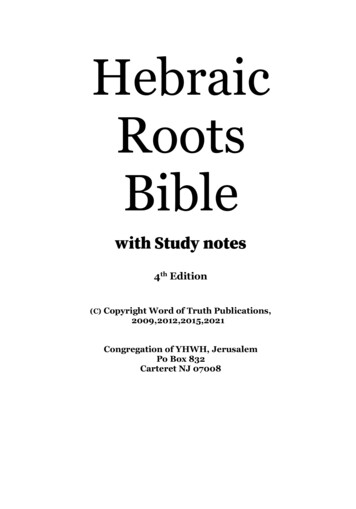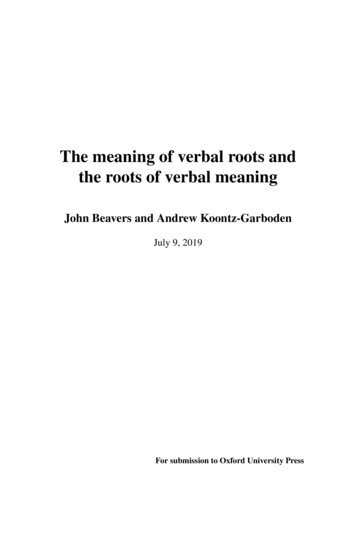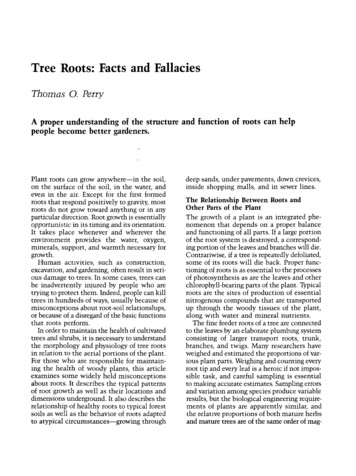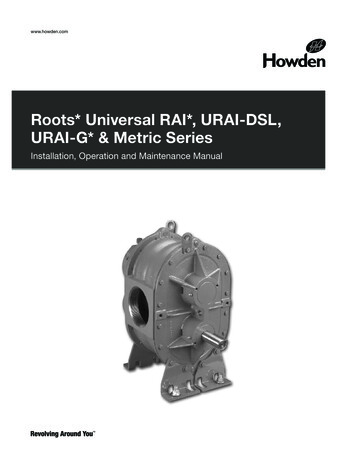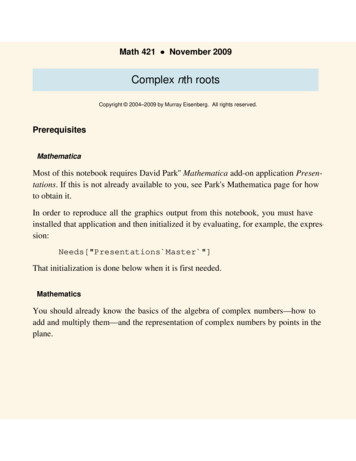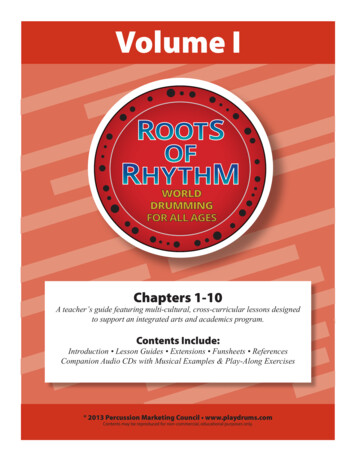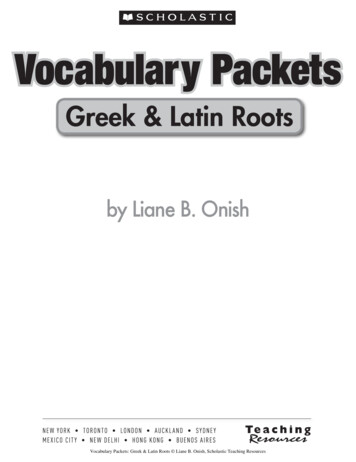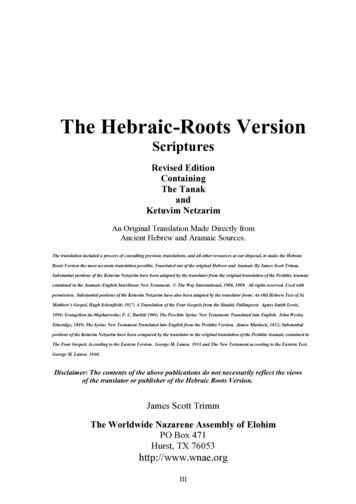
Transcription
The Hebraic-Roots VersionScripturesRevised EditionContainingThe TanakandKetuvim NetzarimAn Original Translation Made Directly fromAncient Hebrew and Aramaic Sources.The translation included a process of consulting previous translations, and all other resources at our disposal, to make the HebraicRoots Version the most accurate translation possible. Translated out of the original Hebrew and Aramaic By James Scott Trimm.Substantial portions of the Ketuvim Netzarim have been adapted by the translator from the original translation of the Peshitta Aramaiccontained in the Aramaic-English Interlinear New Testament. The Way International, 1988, 1989. All rights reserved. Used withpermission. Substantial portions of the Ketuvim Netzarim have also been adapted by the translator from: An Old Hebrew Text of St.Matthew’s Gospel, Hugh Schonfield; 1927; A Translation of the Four Gospels from the Sinaitic Palilmpsest. Agnes Smith Lewis,1894; Evangelion da-Mepharreshe; F. C. Burkitt 1904; The Peschito Syriac New Testament: Translated into English. John WesleyEtheridge, 1849; The Syriac New Testament Translated into English from the Peshitto Version. James Murdock, 1852; Substantialportions of the Ketuvim Netzarim have been compared by the translator to the original translation of the Peshitta Aramaic contained inThe Four Gospels According to the Eastern Version. George M. Lamsa 1933 and The New Testament according to the Eastern Text.George M. Lamsa 1940.Disclaimer: The contents of the above publications do not necessarily reflect the viewsof the translator or publisher of the Hebraic Roots Version.James Scott TrimmThe Worldwide Nazarene Assembly of ElohimPO Box 471Hurst, TX 76053http://www.wnae.orgIII
Table of ContentsPreface. VIIIIntroduction. IXThe Tenak תנך . .1The Torah תורה . .3Genesis. בראשית . 5Exodus שמות . .77Leviticus ןיקרא . .136Numbers במדבר . .178Deuteronomy דברים . .238The Nevi’im נביאים . .288Joshua יהושע . .290Judges שפטים . .326I Samuel שמואל א . .359II Samuel שמואל ב . .403I Kings מלכים א . .440II Kings מלכים ב . .482Isaiah ישעיה . .523Jeremiah ירמיה . .595Ezekiel יחזקאל . 668Hosea הושע . .737Joel יואל . .748Amos עמוס . .752Obadiah עבדיה . .761Jonah יונה . .763Micah מיכה . .766Nahum נחום . .772Habakkuk חבקוק . .775Zephaniah צפניה . .779Haggai חגי . .782Zechariah זכריה . .785Malachi מלאכי . .798The Ketuvim כתובים . 803Psalms תהלים . .805Proverbs משלי . .913Job איוב . .944Song of Songs שיר השירים . 981Ruth רית . .987Lamentations איכה . .992Ecclesiastes קהלת . .1002Esther אסתר . .1013Daniel דניאל . .1025Ezra עזרא . .1047Nehemiah נחמיה . .1062I Chronicles דברי הימים א . .1082IV
II Chronicles דברי הימים ב . .1122Ketuvim Netzarim . .1169The B’sora בשורה / Evangelivan אונגליון . .1171Matthew מתי . .1173Mark מרקוס . .1238Luke לוקא . .1271John (Yochannan) יוחנן . .1326Sh’lukhim שלוחים / Sh’likhe שליחא . .1367Acts סוערנא . .1369James יעקב . .14211st Peter (Kefa) כאפא א . .14272nd Peter (Kefa) כאפא ב . .14331st John (Yochannan) יוחנן א . .14372nd John (Yochannan) יוחנן ב . .14433rd John (Yochannan) יוחנן ג . .1444Jude יהודא . .1445Romans רהומיא . .14471st Corinthians קורנתיא א . .14692nd Corinthians קורנתיא ב . .1489Galatians גלטיא . .1503Ephesians אפסיא . .1510Philippians פיליפסיא . .1518Colossians קולסיא . . .15231st Thessalonians תסלוניקיא א . .15282nd Thessalonians תסלוניקיא ב . .15331st Timothy טימתאוס א . .15362nd Timothy טימתאוס ב . .1543Titus טטוס . .1547Philemon פילמון . .1550Hebrews עברים . .1552Revelation גלינא . .1571V
PREFACETranslating the Word of Elohim into English, or any other language, is an awesome responsibility, and not one that the translator hastaken lightly. The volume before you is the result of many years of research and study. It has been my intent to render the originalHebrew and Aramaic of the Scriptures to produce the best possible English translation. The Tanak (Old Testament) portion of the HRV,is a revision of the JPS 1917 version, which is in the public domain. There are many key revisions however, that make the HRV Tanakquite distinct from the JPS 1917 text. The HRV “New Testament” is an original translation taken directly from the Hebrew and Aramaicsources1. While one cannot help but be influenced by the translations one has known and used in the past, I have nonetheless sought togive an original translation; directly from the Hebrew and Aramaic. This translation is as literal as possible, and follows the originalword order as closely as possible, whenever possible.Finally, I must touch on the concept of the inerrancy of the Scriptures. This is a concept, which I, the translator, hold near and dear. Itmust be emphasized that the concept of inerrancy applies only to the autograph (the original, from the pen of the original author) and notto the many manuscript witnesses that are copies. As a matter of fact, not two manuscripts agree exactly, even in dealing with the GreekNew Testament. So one would be hard pressed to say exactly, which manuscript we have today is the “inerrant” one. The purpose of theHRV is to provide the best possible translation from the Hebrew and Aramaic copies, which bear witness to the inerrant original. Likethose men in the parable of talents, it is our responsibility to do the best we can, with what Elohim has given us.James Trimm1However it should be noted, that the Book of Matthew in the HRV is a revision of my own translation of DuTillet HebrewMatthew, (revised in many places to agree with the Aramaic or other Hebrew witnesses). My translation of DuTillet Matthewwas itself noted on the title page, as a “revision” of previous translations. Among the versions which most strongly influencedthat translation, was a 1927 English translation of the DuTillet text, published by Hugh Schonfield, having passed into the publicdomain. Also it should be noted, that no reliable Hebrew or Aramaic witnesses are yet available for 2Kefa (Peter), 2 & 3Yochanan (John) or Y’huda (Jude), and so these books were translated from Greek with the understanding that the translator wasreaching toward an underlying Aramaic text.VI
INTRODUCTIONWHY THE HEBRAIC ROOTS VERSION?The Hebraic Roots Version (which began as the Semitic New Testament Project), has been a ten year project in order toproduce a new and accurate translation of the New Testament, taken primarily from old Hebrew and Aramaic sources. Unlike mosttranslations, this edition will not be rooted in a Greek Hellenistic text. Instead, this translation will seek to understand the text of the NewTestament from the languages in which it was originally written. This is important, because there are some passages in the NT which donot make sense at all in Greek, but only begin to make sense when we look at them in Hebrew and Aramaic.Acts 11:27-30And in these days prophets came from Jerusalemto Antioch. Then one of them, named Agabus,stood up and showed by the Spirit that there was goingto be a great famine throughout all THE WORLD,which also happened in the days of Claudius Caesar.Then the talmidim, each according to his ability,determined to send relief to the brothers dwellingIN JUDEA. This they also did, and sent it to theelders by the hands of Barnabas and Saul.Now this doesn’t make sense at all. Why would those in Antioch send relief to those dwelling IN JUDEA, if the famine was to strike allTHE WORLD. They would be facing famine themselves. The solution lies in the fact that the word for “WORLD” in the Aramaicmanuscripts is (Strong’s #772), the Aramaic form of the Hebrew word (Strong’s 776). This word can mean “world” (as inProverbs. 19:4), “earth” (as in Dan. 2:35), or “land” (as in Dan. 9:15), and is often used as a euphemism for “The Land of Israel” (as inDan. 9:6). Certainly the word here is not meant to mean “world,” but “Land of Israel.”Mt. 26:9 Mk. 14:3And when Y’shua was in Bethany at the houseof Simon the leper,As any Bible student knows, lepers were not permitted to live in the city (see Lev. 13:46). Since ancient Hebrew and Aramaic werewritten without vowels, there was no distinction between the Aramaic words GAR’BA (leper), and GARABA (jar maker or jarmerchant). Since in this story a woman pours oil from a jar, it is apparent that Simon was a jar merchant, or jar-maker, and not a leper.Mt. 19:12 & Acts 8:26f.there are eunuchs who have made themselves eunuchs for the Kingdom of Heaven’s sake.--Mt. 19:12 NKJVSo he [Phillip] arose and went. And behold, a man of Ethiopia, a eunuch of great authority, under Candace the queen of theEthiopians, who had charge of all her treasury, and had come to Jerusalem to worship.--Acts 8:27 NKJVThe man in Acts 8:27 appears to be a proselyte to Judaism, since he seems to be making the Torah-required pilgrimage to Jerusalem(Deut. 16:16). The Torah however, forbids a eunuch both from becoming a proselyte Jew and from worshipping at the Temple (Deut.23:1f). This also raises the question of why one would become a eunuch (be castrated), for the sake of the Kingdom of Heaven. After all,eunuchs are excluded from the assembly of Israel. The word for “eunuch” in the Aramaic manuscripts of both of these passages is which can mean “eunuch”, but can also mean “believer”, or “faithful one”, as it clearly means here.Mt. 19:24 Mk. 10:25 Luke 18:25.it is easier for a camel to go through the eye of a needle,than for a rich man to enter the Kingdom of God.VII
The word for “camel” in the Aramaic manuscripts is which can mean “camel”, but can also refer to a “large rope,” which iscertainly the meaning here.John 12:11 & 15:16One word that the Greek translators often misunderstood, was the Aramaic word which normally means “to go” or “to depart”, butis used idiomatically in Aramaic to mean that some action goes forward, and that something progresses “more and more”.One case where the Greek translator misunderstood this word, and translated ittoo literally, is in John 12:11:Because that by reason of him, many of the Jewswent away (!?!), and believed on Jesus. (KJV)Now I have translated the Aramaic of this passage as follows:Because many of the Judeans, on account of him,were trusting more and more ( ) in Yeshua.And John 15:16:.that ye should go and bring forth fruit.KJVI have translated from the Aramaic:.that you also, should bear fruit more and more ( ).THE ORIGINAL MANUSCRIPT ORDEROF THE BOOKS OF THE “NEW TESTAMENT”The Hebraic Roots Version restores the books of the “New Testament” to their original manuscript order.Most copies of the New Testament today follow the order:GospelsActsPauline Epistles“Catholic”2 EpistlesRevelationHowever the original manuscript order of the books was:GospelsActs“Catholic” EpistlesPauline EpistlesRevelationThis original manuscript order is followed by the Aramaic Peshitta canon,3 and thus is that which is followed by such well knownPeshitta manuscripts as Codex Khaboris and the Yonan Codex (these two are mentioned by name, not because of their age but becausethey are good examples of complete Peshitta New Testament manuscripts).2It is important to know that the academic term “Catholic Epistles” is not referring to the Catholic Church, but the Churchtradition that these epistles were “universal”; (“Catholic” is Latin for “universal”). These epistles should more accurately becalled “Jewish Epistles” since they are addressed to the Jews and are written by emissaries to the Jews.3Setting aside the fact that the Peshitta Canon does not include 2Pt; 2&3 John; Jude and Rev.VIII
This original manuscript order is also followed by the oldest and best ancient Greek manuscripts of the New Testament, such as CodexVaticanus, Codex Alexandrinus, and Codex Ephraim.This original manuscript order was also followed by Westcott & Hort in their 1881 publication of the Greek New Testament (which theymistakenly believed was the “original”) writing:We have followed recent editors in abandoning the Hieronymic4order [Jerome’s order], familiar in modern Europe through theinfluence of the Latin Vulgate, in favor of the order most highlyrecommended by various Greek authorities of the fourth century;it differs from the Hieronymic order. The Acts are immediatelyfollowed by the Catholic Epistles.(Introduction to the New Testament in the Original Greek, p. 320)In his Introduction to the Textual Criticism of the New Testament Scrivener writes:Whether copies contain the whole, or a part of the sacred volume,the general order of the books is the following: Gospels, Acts,Catholic Epistles, Pauline Epistles and Apocalypse.(Introduction to the Textual Criticism of the New TestamentVol. 1 p. 72)Bullinger writes:Our English Bibles follow the order as given in the Latin Vulgate.This order, therefore, depends on the arbitrary judgment of oneman, Jerome (A.D. 382-429) All theories based on this order reston human authority, and thus are without any true foundation.(Companion Bible, Appendix 95, p. 139)M’Clintock and Strong in their twelve vol. Cyclopedia write:The Western Church as represented by Jerome,gave priority of position to the Pauline epistles. The tendencyof the Western Church to recognize Rome as the centerof authority, may perhaps in part, account for the departurefrom the custom of the East. The order of the Alexandrian,Vatican and Ephraim manuscripts gives precedence to theCatholic Epistles, and this is also recognized by the Councilof Laodicea, Cyril of Jerusalem and Athanasius,(CBTEL, vol. 1, p. 800)The late Dr. Ernest Martin writes:There can be no doubt whatever, that the actual manuscriptarrangement of the New Testament books, should be restoredin all modern versions. .the seven Catholic (“Jewish”)Epistles should be placed in their original position before those ofPaul (Restoring the Original Bible; by Ernest L. Martin p. 16-17)This original manuscript order is also testified to by many of the ancient “Church Fathers”. Athanasius (296-373 CE) Bishopof Alexandria gives the order of books as “the four Gospels; the Acts of the Apostles; the seven Catholic Epistles; the fourteen epistlesof St. Paul; and the Revelation of John”5 Leonitus of Byzantium also gives this order.6 The fourth century “Church Father” Philastriusalso argued that the Catholic Epistles must precede the Pauline epistles because Gal. 1:17 has Paul referring to the Emissaries of theJewish Epistles as coming before him.7 Cyril Bishop of Jerusalem also maintained the original manuscript order8 as did the Council ofLaodicea.94A scholarly term, taken from the Latin pronunciation of “Jerome” and, referring to that which is related to him.See Horne, Introduction, vol. IV, p. 2536ibid7Introduction to the Literature of the New Testament, by Moffat, p. 138Catachetical Lectures 4:369Canon LX5IX
This is another important feature which makes the HRV unique when compared to other Messianic editions. Just as themanuscript order of the books of the Tanak (OT), (followed by Judaism) does not agree with the ordering of the same books in theChristian "Old Testament" as printed today, so also does the manuscript order of the NT differ. The ancient manuscript order of thebooks of the "New Testament" has first the "Gospels" then "Acts" followed by the Jewish Epistles (Ya’akov (James); 1 & 2 Kefa (Peter);1, 2, & 3, Yochanan (John); and Y'hudah (Jude); followed by the Pauline epistles which are followed by Revelation. This order wasrearranged by Rome in the Latin Vulgate, in which the Pauline epistles were given first place and the Jewish epistles given second place.The original manuscript order had an important significance. It agreed with the precept that the message was to the Jews first and then tothe Goyim (Gentiles). It also agrees with the concept that Ya'akov, Kefa, and Yochanan, were emissaries that come BEFORE Paul (Gal.1:17) and with the concept that Kefa, Ya'akov, and Yochanan, served as three pillars which lend authority upon which Paul's messagewas built, (Gal. 2:9) and not vice-versa. The reader of the NT was intended to read the "Jewish" epistles FIRST and then to read thePauline epistles already having understood the Jewish epistles. The NT reader was intended to read Ya'akov's (James') admonitionconcerning faith and works (Ya'akov 2), as well as Kefa's warnings about Paul being difficult to understand and often twisted (2Kefa3:15-16) etc., before ever attempting to understand the writings of Paul. The HRV follows the ancient manuscript order, (which agreesalso with the order of the ancient Aramaic manuscripts) in placing the "Jewish epistles" immediately after Acts, and placing the PaulineEpistles AFTER them.THE ORIGINAL LANGUAGE OF THE NEW TESTAMENTThe original language of the “New Testament” like that of the Tanak (the “Old Testament”), was Hebrew and Aramaic. Thefollowing is just some of the evidence to support this fact. The in depth reader may wish to consult a more detailed treatment of thisissue, in my book “The Hebrew and Aramaic Origin of the New Testament10.”Language of First Century IsraelThe Middle East, through all of its political turmoil, has in fact, been dominated by a single master from the earliest ages untilthe present day. The Semitic tongue has dominated the Middle East, from ancient times until the modern day. Aramaic dominated thethree great Empires: Assyrian, Babylonian, and Persian. It endured until the seventh century, when under the Islamic nation it wasdisplaced by a cognate Semitic language, Arabic. Even today some few Syrians, Assyrians, and Chaldeans, speak Aramaic as theirnative tongue, including three villages north of Damascus.11The Jewish people, through all of their persecutions, sufferings, and wanderings, have never lost sight of their Semitic heritage,nor their Semitic tongue. Hebrew, a Semitic tongue closely related to Aramaic, served as their language until the great dispersion whena cognate language, Aramaic, began to replace it. Hebrew, however continued to be used for religious literature, and is today the spokenlanguage in Israel.The Babylonian ExileSome scholars have proposed that the Jews lost their Hebrew language, replacing it with Aramaic during the Babyloniancaptivity. The error of this position becomes obvious. The Jewish people had spent 400 years in captivity in Egypt,12 yet they did notstop speaking Hebrew and begin speaking Egyptian. Why should they exchange Hebrew for Aramaic, after only seventy years13 inBabylonian captivity? Upon return from the Babylonian captivity, it was realized that a small minority could not speak "the language ofJudah",14 so drastic measures were taken to abolish these marriages and maintain the purity of the Jewish people and language.15 Onefinal evidence rests in the fact that the post-captivity books (Zechariah, Hag., Mal., Nehemiah, Ezra, and Ester) are written in Hebrew,rather than Aramaic.HellenizationSome scholars have also suggested that under the Helene Empire, Jews lost their Semitic language, and, in their rush tohellenize, began speaking Greek. The books of the Maccabees do record an attempt by Antiochus Epiphanies, to forcibly Hellenize theJewish people.16 In response, the Jews formed an army led by Judas Maccabee. 17 This army defeated the Greeks and eradicated10Available at http://www.lulu.com/nazareneThe New Covenant Aramaic Peshitta Text with Hebrew Translation; Bible Society of Jerusalem; 1986; p. iii12Ex. 12:40-41; Acts 7:613Jeremiah 5:11-12; 29:10; Zech. 7:5; Dan. 9:214(Nehemiah 13:23-24) A euphemism for Hebrew as opposed to Aramaic (see 2Kn. 18:26)15Nehemiah 13:23-31; Ezra 10:3-19161Macc. 1:10-15, 41-64; 2Macc. 4:9-17; 6:1-11; Josephus ;Ant. 12:5171Macc 2:19-9; 2Macc. 8f; Josephus ; Ant. 12:611X
Hellenism.18 This military victory is still celebrated today as Chanukkah, the feast of the dedication of the Temple,19 a holiday that evenYeshua seems to have observed at the Temple at Jerusalem in the first century.20 Those who claim that the Jews were Hellenized andbegan speaking Greek at this time, seem to deny the historical fact of the Maccabean success.During the first century, Hebrew remained the language of the Jews living in Judah, and to a lesser extent, in Galilee. Aramaicremained a secondary language and the language of commerce. Jews at this time did not speak Greek. In fact one tradition had it, that itwas better to feed ones children swine, than to teach them the Greek language. It was only with the permission of authorities, that ayoung official could learn Greek, and then, solely for the purpose of political discourse on the National level. The Greek language wascompletely inaccessible, and undesirable, to the vast majority of Jews in Israel in the 1st century.21 Any gauge of Greek language outsideof Israel cannot, nor can any evidence hundreds of years removed from the 1st century, alter the fact that the Jews of Israel in the 1stcentury did not know Greek.The Testimony of JosephusThe first century Jewish historian Flavius Josephus (37-c.100 C.E.) testifies to the fact that Hebrew was the language of firstcentury Jews. Moreover, he testifies that Hebrew, and not Greek, was the language of his place and time. Josephus gives us the onlyfirst hand account of the destruction of the Temple in 70 C.E. According to Josephus, the Romans had to have him, translate the call tothe Jews to surrender, into "their own language". 22 Josephus gives us a point-blank statement regarding the language of his peopleduring his time:I have also taken a great deal of pains to obtain the learningof the Greeks, and to understand the elements of the Greeklanguage. Although, I have so long accustomed myself to speakour own language, that I cannot pronounce Greek withsufficient exactness: for our nation, does not encourage thosethat learn the languages of many nations.23Thus, Josephus makes it clear, that first century Jews could not even speak or understand Greek, but spoke "their own language."ArchaeologyConfirmation of Josephus's claims has
Translating the Word of Elohim into English, or any other language, is an awesome responsibility, an d not one that the translator has . (revised in many places to agree with the Aramaic or other Hebrew witnesses). My translati on of DuTillet Matthew . As any Bible student knows, lepe


